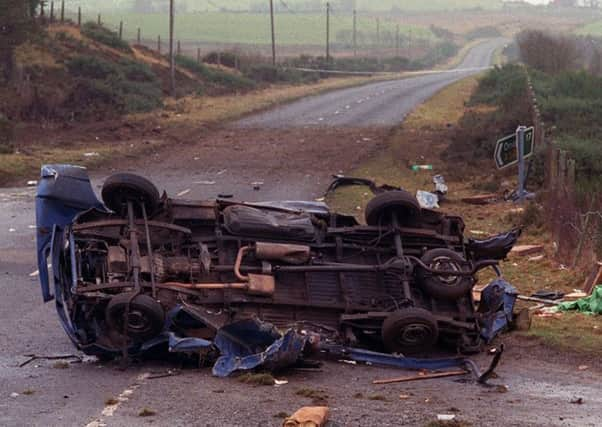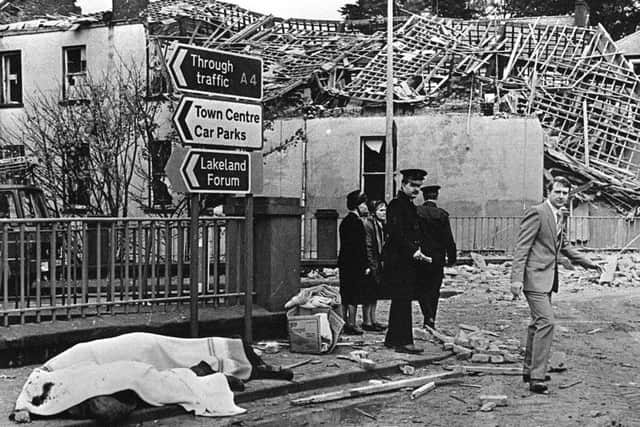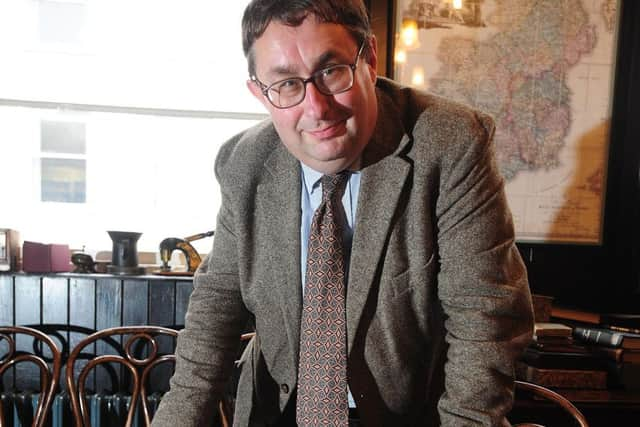PIRA murders of civilians were deliberate more than accidental


The journalist Peter Taylor has recently caused controversy by his remarks about the Provisional IRA’s attitude to violence against civilians.
In two interviews, one on BBC One and the other on Radio Ulster, he has said that although the Provisional IRA (hereafter PIRA or the Provisionals) killed many civilians,”by and large the IRA tactic was not to deliberately kill civilians” (It is assumed that Mr Taylor’s references to the IRA mean the Provisionals rather than the Officials or any dissidents).
Advertisement
Hide AdAdvertisement
Hide AdIn his second interview Mr Taylor qualified his earlier statement by saying that there were a few notable exceptions to this general rule; in this respect he instanced the Tullyvallen and Kingsmills atrocities of, respectively, 1975 and 1976.


Mr Taylor also contended that PIRA’s 1987 Remembrance Sunday bomb in Enniskillen was directed against the security forces, not civilians, adding that ”it didn’t actually pay the IRA to massacre and kill civilians”.
Peter Taylor has made similar remarks before-notably in his book (‘Talking to Terrorists,’ 2011).
It must be made clear that he has said that he does not support terrorist violence and he has written that he believes that “conflicts should be resolved through dialogue, not destruction”.
Advertisement
Hide AdAdvertisement
Hide AdMore recently he has said that he has “never sanitised the IRA’s history”.


Mr Taylor’s statement that he does not support terrorism must be accepted without qualification.
More problematic is his claim that he has not sanitised PIRA’s activities.
The claim that PIRA did not seek deliberately to kill civilians has been made not only by Mr Taylor and other commentators but also by spokesmen for the Provisionals.
Advertisement
Hide AdAdvertisement
Hide AdA similar account to his of PIRA’s attitude to murders of civilians is in essence that given by the Provisionals themselves.


It is understandable therefore that Mr Taylor’s remarks have caused hurt as well as controversy.
Understandable – and justifiable also; in this article it will be argued that the reverse of Mr Taylor’s case is true. Deliberate rather than accidental murders of civilians by PIRA were the rule, not the exception.
It will also be contended that the number of civilians deliberately murdered by PIRA may exceed 700 – a figure greater by sixty or more than those usually given.
Advertisement
Hide AdAdvertisement
Hide AdMr Taylor’s assertion that there were only a few notable exceptions to PIRA’s alleged practice of not murdering civilians deliberately is as hard to explain as it is to accept.


Several politicians were murdered by PIRA. They include the Irish senator Billy Fox, murdered in March 1974; or Robert Bradford MP (murdered in October 1981 along with a caretaker, Kenneth Campbell); or Edgar Graham, the Assembly member (murdered in December 1983); Sir Anthony Berry MP (murdered in October 1984 with Roberta Wakeham, Jeanne Shattock, Eric Taylor and Muriel MacLean); or Ian Gow (murdered in July 1990).
PIRA murdered the octogenarian Sir Norman Stronge and his son James in January 1981. In November 1975 PIRA murdered the television presenter Ross McWhirter.
The census collector Joanne Mathers, killed in April 1981, was murdered – it is believed – on the orders of the recently deceased and much lauded Martin McGuinness .
Advertisement
Hide AdAdvertisement
Hide AdMr Taylor must know of PIRA’s murders of HM Ambassador to Dublin Christopher Ewart-Biggs along with the civil servant Judith Cook in July 1976.
And surely he must know too of PIRA’s murders in March 1979 of HM Ambassador to the Hague Sir Richard Sykes and his valet Karel Straub?
Likewise he must be aware of PIRA’s murders of businessmen such as Jeffrey Agate (in February 1977); or Robert Mitchell (also February 1977); or Peter Hill (again February 1977); or (in the following month) the murders of Donald Robinson and Christopher Shaw.
He must know too of the many prisoner officers murdered by PIRA.
Advertisement
Hide AdAdvertisement
Hide AdJudges and magistrates were murdered by PIRA, such as Martin Mc Birney and Rory Conaghan (both in September 1974); or William Doyle (murdered in January 1983); or Sir Maurice Gibson (murdered in April 1987 along with Lady Gibson).
The school teacher Mary Travers was murdered in April 1984 when PIRA’s goons tried to murder her magistrate father; her murderers tried also to kill her mother.
This plot to wipe out three family members as they left a Sunday celebration of mass is reminiscent –sickeningly so –of gangland murders.
Mr Taylor must also know about PIRA’s murders of the disappeared such as (to give but three cases) Jean McConville (in December 1972); Columba McVeigh (in November 1975); or Charles Armstrong (in August 1981).
Advertisement
Hide AdAdvertisement
Hide AdHe cannot have forgotten the many alleged informers murdered by PIRA.
He must be aware to of PIRA’s Claudy bombs or those of Bloody Friday (both July 1972);and PIRA’s Newry bomb in August 1972; or the murderous PIRA bombs in Coleraine ( August 1973); or the PIRA Birmingham bombs of November 1974; or the PIRA bomb at the La Mon Hotel (February 1978).
Other people were murdered because they were civilian employees of the Ministry of Defence or supplied materials to the security forces – men such as Patsy Gillespie (October 1990) and John Haldane (Sept 1991). At Teebane in January 1992 eight Protestants were murdered because they were working on a military base.
One could go on listing PIRA’s murders and atrocities, all committed with ruthlessness and savagery. Those not mentioned have been omitted only due to lack of space.
Advertisement
Hide AdAdvertisement
Hide AdMr Taylor mentions some of the above murders in his books. Does he not regard these murders as deliberate? Or does he not regard those murdered as civilians?
Mr Taylor’s belief that PIRA rarely murdered civilians on purpose seems at best naïve.
The evidence is only too strong against his claims.
In the case of the Remembrance Sunday bomb in Enniskillen in November 1987, his claim that the bomb was directed against the security forces was rejected some years ago in a HET report.
Anyone familiar with the geography of Belmore Street in Enniskillen as it was in November 1987 before the bomb will not need even an authoritative HET report to know that Mr Taylor’s case lacks all foundation.
Advertisement
Hide AdAdvertisement
Hide AdThe bomb was planted in St Michael’s Reading Rooms against a wall on whose exterior civilian congregants were accustomed to gather each Remembrance Sunday; the wall provided shelter and a viewing point for the ceremony at the War Memorial.
Security force personnel did not assemble there. This must have been known to IRA murderers as republican activists were observed at the previous year’s ceremony.
The bomb was planted in a location which guaranteed that civilians would be murdered (or at least injured) on a large scale. The bombers’ objective was realised.
All of whose victims were Protestant, which fits into the pattern of PIRA sectarian murders in border counties.
Advertisement
Hide AdAdvertisement
Hide AdIt came months after Ken Maginnis’s victory in the Fermanagh-South Tyrone constituency at the 1987 general election; the seat had been occupied briefly by the PIRA terrorist and hunger striker Bobby Sands and republicans regarded the constituency as theirs by right.
One purpose of the bomb was to punish and intimidate border Protestants; the murders were as sectarian as any committed by the UDA or UVF.